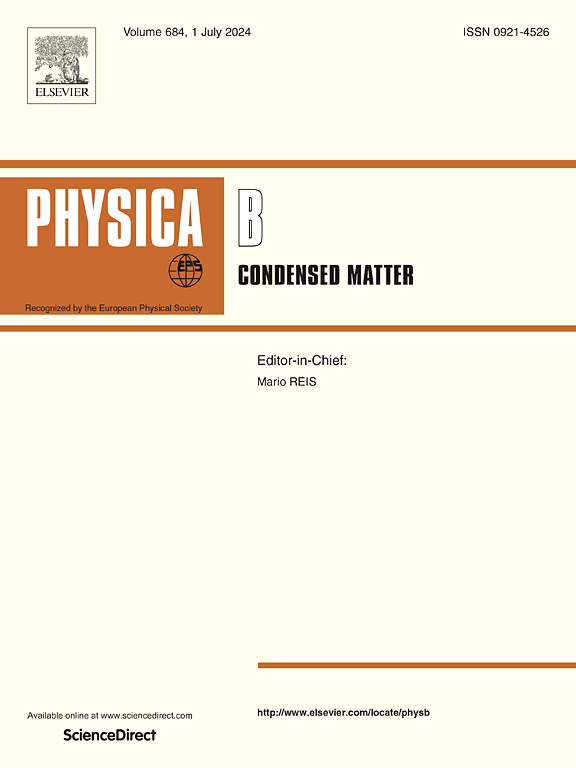Spectroscopic studies of neodymium-doped borate glasses and calculation of Judd-Ofelt parameters
IF 2.8
3区 物理与天体物理
Q2 PHYSICS, CONDENSED MATTER
引用次数: 0
Abstract
Borate glasses doped with Nd2O3 [H3BO3-Pb3O4-ZnO-X Nd2O3] have been prepared using the rapid cooling method. Glasses containing different concentrations of Nd2O3 doped were prepared in the temperature range of 1100 °C. The glassy nature of the synthesized samples is confirmed by the X-ray diffraction (XRD) pattern. Laser Raman spectra have been recorded using 532 nm and 785 nm laser excitation to study the vibrational nature of the glass structure. In the FT-IR studies, identify the functional group in the neodymium-doped borate glasses. The absorption spectra Tauc plot is used to calculate the optical band gap of the synthesized sample. The spectroscopic properties of the neodymium-doped ions were measured by the Judd-Ofelt theory. Furthermore, to study the synthesized glasses' spectroscopic properties, the absorption spectra are recorded in the range of 400 nm–900 nm. Moreover, the Judd-Ofelt parameter has been calculated for the synthesized sample, the calculated values of Ωλ X 10−20 cm2 (λ = 2,4,6) are 2.78, 2.43, 2.57 for BNdBAG, 1.43, 0.97, 1.27 for CNdBAG and 1.48, 1.01, 1.31 for DNdBAG glasses. The spectroscopic quality factor is also calculated for all the synthesized samples. The Judd Ofelt parameter follows the trends Ω2 > Ω6 > Ω4. Phonon lifetime is calculated for all the synthesized samples. Three near-IR emission bands were observed in the neodymium ions-doped borate glasses under the excitation of a 532 nm laser diode. The radiative transitions of 4F3/2 → 4I9/2, 4F3/2 → 4I11/2, and 4F3/2 → 4I13/2 are responsible for the three main emission bands that are produced by the lasing action of Nd3+-doped glass at approximately 902, 1021, and 1343 nm, respectively. The radiative lifetime (τR) and the decay radiative rate (WR) are also calculated by using fluorescence spectra.
求助全文
约1分钟内获得全文
求助全文
来源期刊

Physica B-condensed Matter
物理-物理:凝聚态物理
CiteScore
4.90
自引率
7.10%
发文量
703
审稿时长
44 days
期刊介绍:
Physica B: Condensed Matter comprises all condensed matter and material physics that involve theoretical, computational and experimental work.
Papers should contain further developments and a proper discussion on the physics of experimental or theoretical results in one of the following areas:
-Magnetism
-Materials physics
-Nanostructures and nanomaterials
-Optics and optical materials
-Quantum materials
-Semiconductors
-Strongly correlated systems
-Superconductivity
-Surfaces and interfaces
 求助内容:
求助内容: 应助结果提醒方式:
应助结果提醒方式:


